Your Silent Partner Wants You
The global equity markets continue to march forward in-spite of valuations.[i]

The cyclically adjusted P/E (CAPE) ratio for the S&P 500, a 10-year average earnings compared to current price, is at historic levels only seen a few times in the last 100 years. Robert Shiller, the creator of this metric, suggests stocks may be in "nose bleed" territory.[ii]
Historical CAPE and Long-Term Interest Rates (1880 to Present)
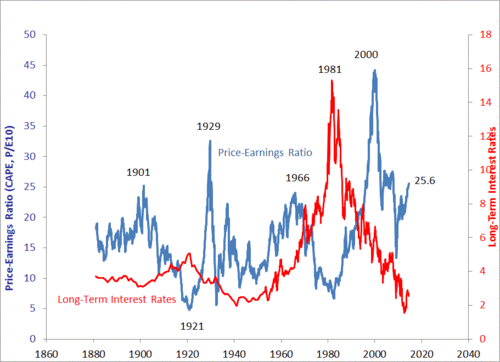
With a reading of 25.6, the metric has been higher only three times since 1880 - in 1929, 2000 and 2007.[iii]
This would seem to suggest that we are in store for a correction of some sort. However, there are a few data points one should consider before accepting the obvious (although the obvious might be precise).
1) Spending continues to match income with both rising about 4% year-over-year in May. Personal consumption was up 0.2% in May after no growth in April. This bodes well for a stronger Q2.[iv]
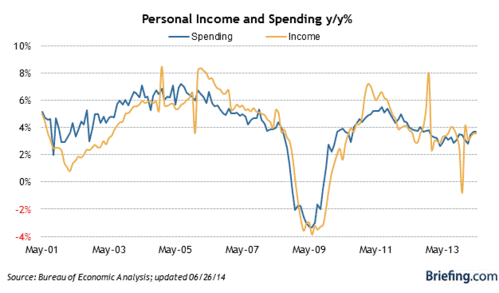
2) Consumer confidence is showing very positive signs that suggest consumers are willing to spend. Consumer confidence is near a 6-year high.[v]
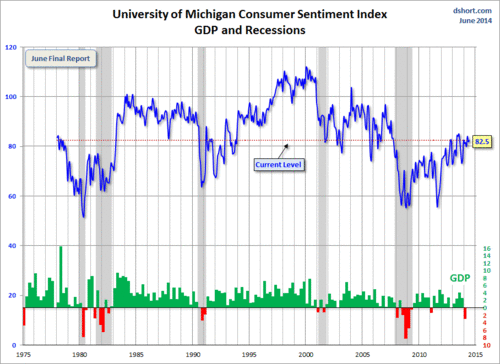
3) Individual investors tend to be very predictive of market tops and bottoms in a contrary way. I mean no offense, but past indicators on individual investor sentiment suggest that they are pretty good at being wrong. According to the American Association of Individual Investors, investors are not getting wildly bullish regardless of what the main stream media suggests. From the data below, they appear to be both concerned and optimistic.[vi]
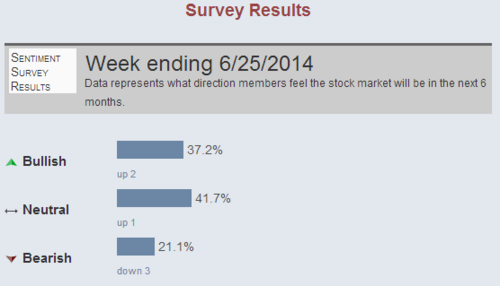
4) Further, mutual fund flows suggest some investors have indeed been selling out of their U.S. equity holdings.[vii]
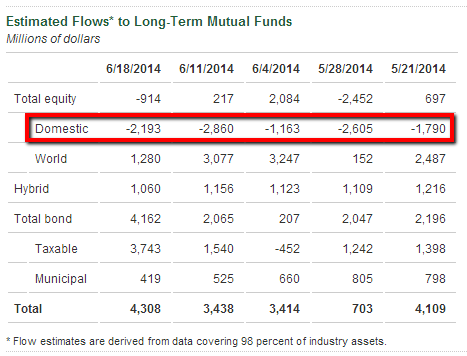
5) The highest tax bracket investors are faced with the daunting task of paying increased capital gains rates, and those earning over $200,000 may owe a 3.8% Medicare surcharge tax, with no place to go.[viii]
6) Finally, returns on fixed income continue to be persistently low. Looking at the historical CAPE chart, long-term interest rates were generally much higher at each of the past CAPE peaks: around 3.5% in 1929, 5% in 1966, 6% in 2000, and 5% in 2000.[ix] Today we are at 2.54% on the 10-year Treasury and 3.36% on the 30-year.[x]
While markets appear extended, it wouldn't surprise me if they continued their modest gains under low volatility. Until rates actually rise, there really is nowhere for investors to find returns. They either reallocate assets into other equity asset classes or park funds in zero-return cash.
While your silent business partner (The US Government) will appreciate you paying your capital gains and Obamacare taxes, all to get near zero returns for investing in safe assets, I'm just not sure how your lifestyle in the future will appreciate that.
It's more critical in the current market cycle to assess your holding time frame in case you need to weather a storm. If you can maintain your lifestyle or institutional needs for a 5-7 year period, deferring the benefits to your silent partner might be worth it.
If you have questions or comments, please let us know as we always appreciate your feedback. You can get in touch with us via Twitter, Facebook, or you can email me directly. For additional information on this, please visit our website.
Tim Phillips, CEO – Phillips & Company
Jeff Paul, Senior Investment Analyst – Phillips & Company
References
[i] Businessweek.com. (Jun 30, 2014). World Stock Markets & Stock Index Performance.
[ii] The Capital Spectator. (Jun 26, 2014). CAPE Crusades.
[iii] Ibid.
[iv] Briefing.com (Jun 26, 2014). Personal Income and Spending.
[v] Short, D. (Jun 29, 2014). Final June 2014 Michigan Consumer Sentiment: A Small Improvement.
[vi] American Association of Individual Investors. (Jun 25, 2014). Sentiment Survey.
[vii] Investment Company Institute. (Jun 25, 2014). Estimated Long-Term Mutual Fund Flows.
[viii] Dzombak, D. (Mar 29, 2014). Capital Gains Tax Rate for 2013 and 2014: 58% Increase for Top Earners.
[ix] The Capital Spectator. (Jun 26, 2014). CAPE Crusades.
[x] U.S. Department of the Treasury. (Jun 30, 2014). Daily Treasury Yield Curve Rates as of June 27, 2014.